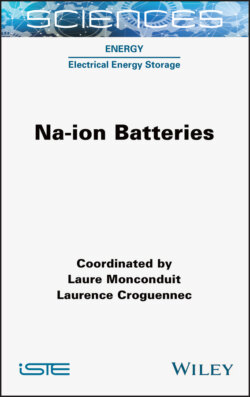Читать книгу Na-ion Batteries - Laure Monconduit - Страница 24
1.3.1.1. O3-NaScO2, O3-NaTiO2 and O3-NaVO2
ОглавлениеAs expected from the empty 3d orbital of Sc(III), O3-NaScO2 (Hoppe et al. 1965) is electrochemically inactive and almost no capacity is observed in the voltage range of 1.5–4.5 V (Kubota et al. 2018b). In contrast, O3-NaTiO2 is electrochemically active and delivers reversible capacity of ca. 150 mAh g−1 based on Ti3+/4+ redox in the voltage range of 0.6–1.6 V in a Na cell (Maazaz and Delmas 1982; Maazaz et al. 1983; Wu et al. 2015). In the voltage range, the working voltage is low (ca. 1.0 V) and charging (oxidation) to >1.6 V leads to the irreversible change in the voltage profile and the capacity decay during charge-discharge cycles (Maazaz et al. 1983). O3-NaTiO2 is, thus, possibly available as a negative electrode material for Na-ion batteries. In contrast to O3-NaTiO2 (Maazaz and Delmas 1982; Maazaz et al. 1983), Na (de)intercalation properties of O3-NaVO2 were first reported in 2011 by Didier et al. (2011) and Hamani et al. (2011). O3-NaVO2 delivers a reversible capacity of 126 mAh g−1 corresponding to 0.5 mol Na extraction/insertion from/into NaVO2 in the voltage range of 1.4–2.5 V in a Na cell. O3-NaVO2 represents a very flat voltage plateau at 1.8 V and a large voltage jump from 1.8 to 2.1 V on the charging (Na-extraction) process. In general, the very flat voltage plateau originates from a large difference of formation energies between different Na contents of the terminal phases, e.g. O3-NaVO2 and O’3-Na0.5VO2, and the two phases coexist on the voltage plateau region, while a small difference of formation energies between the different Na-content phases leads to monophasic solid solution–like reactions with sloping voltage curves. In addition, the voltage steps correspond to phase transitions and/or Na+/vacancy orderings as described above. Similar to O3-NaTiO2, charging to >2.5 V suffers capacity decay probably due to irreversible migration of vanadium ions into the interslab space (Didier et al. 2011). Thus, the low working voltage of O3-NaVO2 is also unavailable as a positive electrode material.
